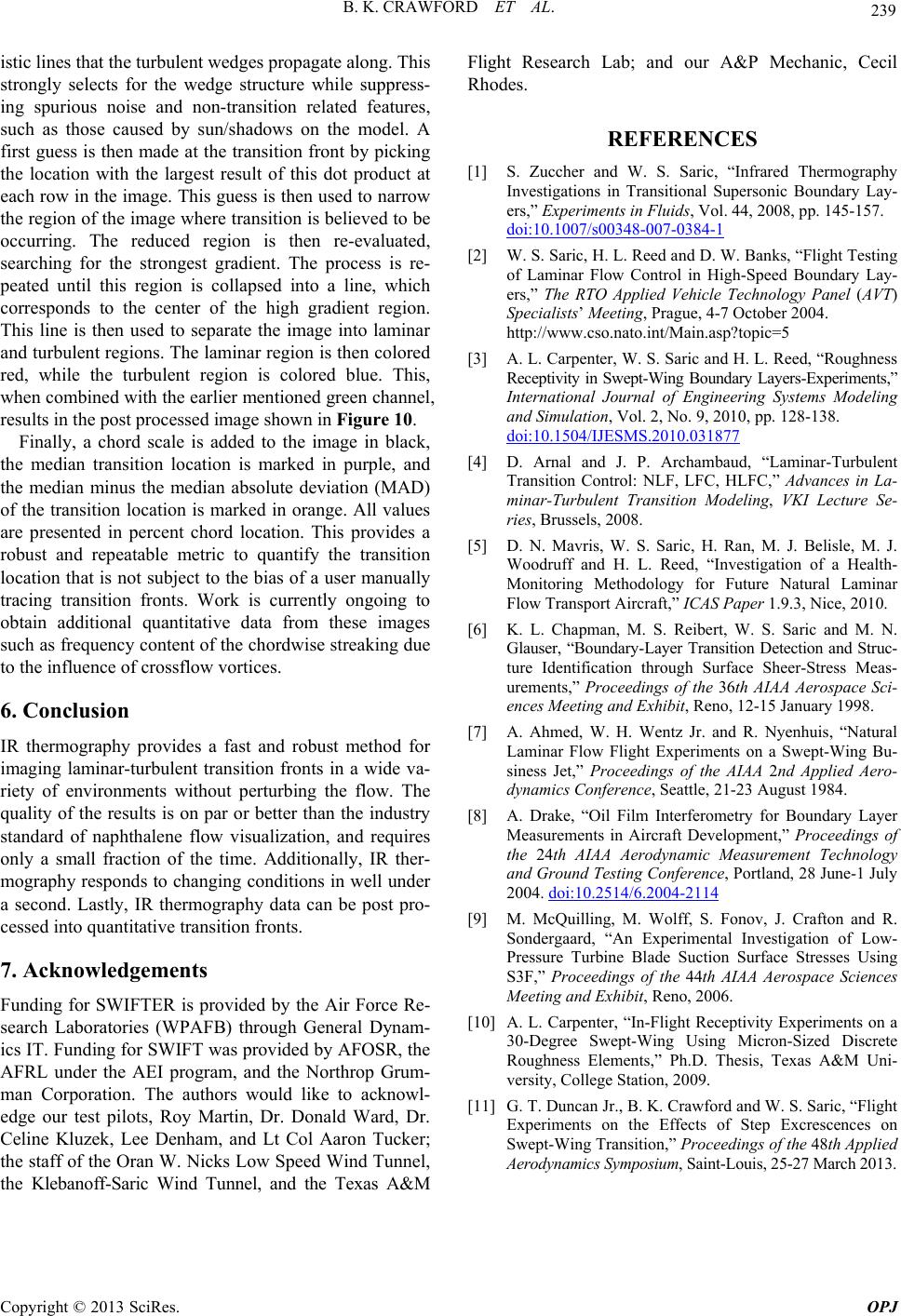
B. K. CRAWFORD ET AL.
Copyright © 2013 SciRes. OPJ
239
edges propagate along. This
st
of
obust method for
rbulent transition fronts in a wid
s without perturbing the flow.
e Air Force Re-
) through General Dynam-
as provided by AFOSR, the
REFERENCES
[1] S. Zuccher ared Thermography
Investigationsnic Boundary Lay-
istic lines that the turbu lent w
rongly selects for the wedge structure while suppress-
ing spurious noise and non-transition related features,
such as those caused by sun/shadows on the model. A
first guess is then made at the transition front by picking
the location with the largest result of this dot product at
each row in the image. This guess is then used to narrow
the region of the image where transition is believed to be
occurring. The reduced region is then re-evaluated,
searching for the strongest gradient. The process is re-
peated until this region is collapsed into a line, which
corresponds to the center of the high gradient region.
This line is then used to separate the image into laminar
and turbulent regions. The lamin ar region is then colored
red, while the turbulent region is colored blue. This,
when combined with th e earlier mentioned green chan nel,
results in the post processed image shown in Figure 10.
Finally, a chord scale is added to the image in black,
the median transition location is marked in purple, and
the median minus the median absolute deviation (MAD)
the transition location is marked in orange. All values
are presented in percent chord location. This provides a
robust and repeatable metric to quantify the transition
location that is not subject to the bias of a user manually
tracing transition fronts. Work is currently ongoing to
obtain additional quantitative data from these images
such as frequency content of the chordwise streaking due
to the influence of crossflow vortices.
6. Conclusion
IR thermography provides a fast and r
imaging laminar-tu
riety of environmente va-
The
quality of the results is on par or better than the industry
standard of naphthalene flow visualization, and requires
only a small fraction of the time. Additionally, IR ther-
mography responds to ch anging conditions in well under
a second. Lastly, IR thermography data can be post pro-
cessed into quantitative transition fronts.
7. Acknowledgements
Funding for SWIFTER is provided by th
search Laboratories (WPAFB
ics IT. Funding for SWIFT w
AFRL under the AEI program, and the Northrop Grum-
man Corporation. The authors would like to acknowl-
edge our test pilots, Roy Martin, Dr. Donald Ward, Dr.
Celine Kluzek, Lee Denham, and Lt Col Aaron Tucker;
the staff of the Oran W. Nicks Low Speed Wind Tunnel,
the Klebanoff-Saric Wind Tunnel, and the Texas A&M
Flight Research Lab; and our A&P Mechanic, Cecil
Rhodes.
nd W. S. Saric, “Infra
in Transitional Superso
ers,” Experiments in Fluids, Vol. 44, 2008, pp. 145-157.
doi:10.1007/s00348-007-0384-1
[2] W. S. Saric, H. L. Reed and D. W. Banks, “Flight Testing
of Laminar Flow Control in Hig
h-Speed Boundary Lay-
oughness
-Experiments,”
ers,” The RTO Applied Vehicle Technology Panel (AVT)
Specialists’ Meeting, Prague, 4-7 October 2004.
http://www.cso.nato.int/Main.asp?topic=5
[3] A. L. Carpenter, W. S. Saric and H. L. Reed, “R
Receptivity in Swept-Wing Boundary Layers
International Journal of Engineering Systems Modeling
and Simulation, Vol. 2, No. 9, 2010, pp. 128-138.
doi:10.1504/IJESMS.2010.031877
[4] D. Arnal and J. P. Archambaud, “Laminar-Turbulen
Transition Control: NLF, LFC, HLt
FC,” Advances in La-
Reed, “Investigation of a Health-
-
gs of
minar-Turbulent Transition Modeling, VKI Lecture Se-
ries, Brussels, 2008.
[5] D. N. Mavris, W. S. Saric, H. Ran, M. J. Belisle, M. J.
Woodruff and H. L.
Monitoring Methodology for Future Natural Laminar
Flow Transport Aircraft,” ICA S Paper 1.9.3, Nice, 2010.
[6] K. L. Chapman, M. S. Reibert, W. S. Saric and M. N.
Glauser, “Boundary-Layer Transition Detection and Struc-
ture Identification through Surface Sheer-Stress Meas-
urements,” Proceedings of the 36th AIAA Aerospace Sci-
ences Meeting and Exhibit, Reno, 12-15 January 1998.
[7] A. Ahmed, W. H. Wentz Jr. and R. Nyenhuis, “Natural
Laminar Flow Flight Experiments on a Swept-Wing Bu
siness Jet,” Proceedings of the AIAA 2nd Applied Aero-
dynamics Conference, Seattle, 21-23 August 1984.
[8] A. Drake, “Oil Film Interferometry for Boundary Layer
Measurements in Aircraft Development,” Proceedin
the 24th AIAA Aerodynamic Measurement Technology
and Ground Testing Conference, Portland, 28 June-1 July
2004. doi:10.2514/6.2004-2114
[9] M. McQuilling, M. Wolff, S. Fonov, J. Crafton and R.
Sondergaard, “An Experimental Investigation of Low-
icron-Sized Discrete
f Step Excrescences on
Pressure Turbine Blade Suction Surface Stresses Using
S3F,” Proceedings of the 44th AIAA Aerospace Sciences
Meeting and Exhibit, Reno, 2006.
[10] A. L. Carpenter, “In-Flight Receptivity Experiments on a
30-Degree Swept-Wing Using M
Roughness Elements,” Ph.D. Thesis, Texas A&M Uni-
versity, College Station, 2009.
[11] G. T. Duncan Jr., B. K. Crawford and W. S. Saric, “Flight
Experiments on the Effects o
Swept-Wing Transition,” Proceedings of the 48th Applied
Aerodynamics Symposium, Saint-Louis, 25-27 March 2013.